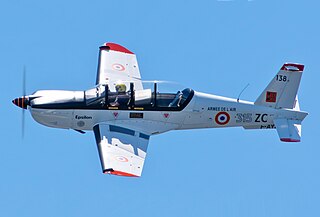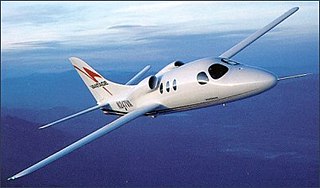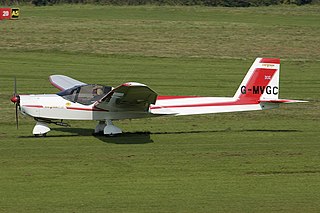Related Research Articles

The Tupolev Tu-126 was an airborne early warning and control aircraft developed from the Tupolev Tu-114 airliner by the Tupolev design bureau. It was in service with the armed forces of the Soviet Union from 1965 to 1984.

The Kamov Ka-15 was a Soviet two-seat utility helicopter with coaxial rotors, which first flew on 14 April 1952 at the hands of test pilot D. K. Yefremov. It was the world's first mass-produced coaxial helicopter. State acceptance trials were completed in 1955, and the helicopter entered production the following year at aircraft factory No. 99 in Ulan-Ude. It was a precursor to the Ka-18 and was fitted with the M-14 engine. It was primarily used for bush patrol, agricultural purposes and fishery control.

The Yakovlev Yak-15 was a first-generation Soviet turbojet fighter developed by the Yakovlev design bureau (OKB) immediately after World War II. The main fuselage was that of Yakovlev Yak-3 piston-engine fighter modified to mount a reverse-engineered German Junkers Jumo 004 engine. The Yak-15 and the Swedish Saab 21R were the only two jets to be successfully converted from piston-power to enter production. 280 aircraft were built in 1947. Although nominally a fighter, it was mainly used to qualify piston-engine-experienced pilots to fly jets.

The Heinkel He 118 was a prototype German monoplane dive bomber design that lost out to the Junkers Ju 87 Stuka in the 1930s, and was never ordered by the Luftwaffe.

The Boeing XF8B was a single-engine aircraft developed by Boeing during World War II to provide the United States Navy with a long-range shipboard fighter aircraft. The XF8B was intended for operation against the Japanese home islands from aircraft carriers outside the range of Japanese land-based aircraft. Designed for various roles including interceptor, long-range escort fighter, dive-bomber, and torpedo bomber, the final design embodied a number of innovative features in order to accomplish the various roles. Despite its formidable capabilities, the XF8B-1 never entered series production.

The PZL 130 Orlik is a Polish turboprop, single engine, two seat trainer aircraft.

The Socata TB 30 Epsilon is a light military trainer aircraft produced by SOCATA. It is a tandem two-seater with a metal airframe. The first prototype flew on 22 December 1979.

The PZL-105 Flaming (flamingo) is a Polish short-takeoff-and-landing (STOL) utility aircraft designed by PZL "Warszawa-Okęcie". It remained a prototype.
The JDM Roitelet was a single-seat light aircraft marketed in France by Avions JDM shortly after World War II. However, only a single example is known to have been built. It was a low-wing, open cockpit monoplane with tailskid undercarriage.

The Promavia F.1300 Jet Squalus, also known as Promavia Jet Squalus F1300, was a two-seat light jet trainer designed by Italian Stelio Frati and built by Promavia in Belgium with support from the Belgian government.

The Ruschmeyer R 90 is a four-seat light aircraft designed and produced in Germany in the late 1980s and early 1990s.

The Robin R 3000 is a French single-engined light aircraft designed and built by Avions Robin, which entered production in the 1980s.
The Fisher Culex and Culite are a family of American two-seat, twin-engined monoplanes. The aircraft is supplied in the form of blueprints for amateur construction, originally by Fisher Flying Products and now by Mike Fisher Aircraft.

The VisionAire VA-10 Vantage is a prototype single-engined light business-jet designed and developed by the American company VisionAire Jets Corporation. Originally planned for production in the late 1990s, the original VisionAire Corporation failed in 2003. The project was acquired by Eviation Jets, which planned to produce it as the redesigned EV-20 Vantage Jet. Eviation also failed, and in 2012 the design was relaunched by a revived VisionAire under its original design.

The Grinvalds Orion is one of the earliest (1981) composite kit- and homebuilt aircraft. A 2/4 seater with a single pusher engine, it was built in France and the United States in small numbers with several variations.
The Sequio 300 Sequoia is an American two-seat utility or aerobatic aircraft, designed by David Thurston for Sequoia Aircraft Corporation for sale as a kit or set of plans for homebuilding.
The IAC Mamba is an Australian two-seat light aircraft. It was designed and built by the Melbourne Aircraft Corporation (MAC) and first flew in 1989 as the MAC Mamba. In 1990, MAC changed its name to the International Aircraft Corporation (IAC).
The VTOL Aircraft Phillicopter is a 1970s Australian light utility helicopter designed and built by VTOL Aircraft of Newcastle West, New South Wales.
The Indaer Peru Chuspi is a Peruvian single-engined light aircraft. Twelve aircraft were built between 1987 and 1990.

The AMF Chevvron is a British two-seat microlight aircraft of the 1980s and 90s. It is a single engined mid-winged monoplane with side-by-side seating. 41 were built.
References
Notes
Bibliography
- "First-flight Delay for AA300 Rigel trainer". Flight International. March 27, 1991.
- Gunston, Bill (1993). World Encyclopedia of Aircraft Manufacturers. Anapolis, Maryland: Naval Institute Press.
- Lambert, Mark (1991). Jane's All The World's Aircraft 1991–92. Coulsdon: Jane's Data Division.
- Taylor, Michael J. H. (1993). Jane's Encyclopedia of Aviation. London: Studio Editions.
- Subodo, Sudiro (31 July 2020). "Pesawat Latih Jet Buatan Indonesia, Antara Ambisi dan Oportunis" [Jet Training Aircraft Made in Indonesia: Between Ambition and Opportunism]. AviaHistoria: Aviation History of Indonesia. Retrieved 4 June 2024.